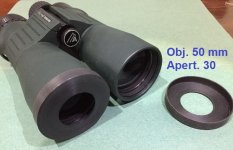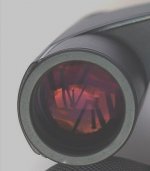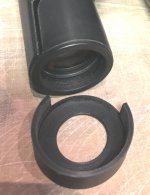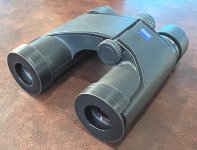I have done this with two binoculars.
In the Alpen Teton 15x50 CA control is improved dramatically by such caps. See the first photo. In the new bino CA was so bad it was to me unusable, in good light at times I could not tell the purple flowers on a tree from its green leaves (literal truth), but now the image is "alpha" class!
The caps were machined locally, of nylon, and weigh 6 g each.
The great reduction in obj. area and exit pupil does bother me, but the striking increase in information useful for bird ID, i.e. spacial detail and coloration, over the best 10x instruments, handheld (my hands are on the steadier side), make it very viable.
In dimmer light I take these caps off. This works much of the time. Even in low light, though, certain conditions make the CA then reappear.
First I trialed models cobbled of black paper, and decided 30 mm was safe. In the well-made present items a bigger aperture may work, but I'm hesitant to try. Maybe we'll go up 2 mm at a time. But then when the CA reappears I'll need to order and pay again for two caps, with aperture stopped back down by that last 2 mm to optimum diameter! Maybe I should ask the machine place whether they can somehow do a trial pair at lower cost and also then indulge my requests for incremental widening.
Next has been the Zeiss Victory Pocket 8x25. In this bino I am bothered by "brightness washout" especially against a very bright background but to a lesser degree at all times. In the former condition glare and harsh contrast obliterate detail. Sometimes CA bothers. In other conditions, to me, vision feels stressed and also color rendition appears too "cold".
A couple weeks ago I had a pair of caps machined by the same place for this instrument at 20 mm aperture. See photos. There's a bit of a snag. As the first pic, cropped from an image from Scopeviews (thanks!), shows the outer surface of the barrel is molded a little farther out for a quarter of the circumference. The wrap side of the cap needs to be cut out for this. See the other two pics. The caps weigh 3 g each.
There's a striking improvement on both counts. I see distinctly more detail against a bright sky. CA then is slightly less. In other and less bright conditions, to me, vision is relaxed, colors are more natural, and the image seems even sharper. The slight narrowing of the very wide field of view is noticeable to me only when comparing it with caps on vs off. In dim light I take them off.
As above, maybe I'll try to open out the aperture to an optimum, some later time.









